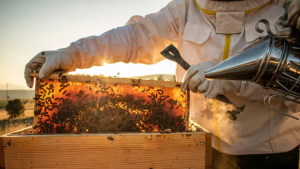
Honey bees are invaluable both for biodiversity and agriculture as they are excellent pollinators, yet their numbers worldwide have been dropping dramatically. The causes include climate change, habitat loss, pesticide use and diseases.
It is in this latter category of threats that entomologists from the University of Florida, the Agricultural Research Service-USDA, Louisiana State University and the University of Nebraska-Lincoln have made marked progress. They have done so by prompting honey bees’ cells to produce free radicals for protecting the insects against a range of potentially deadly viruses.
In field studies researchers used a compound called pinacidil to alter potassium ion channels, a protein found in the cells of bees’ and other iving things. Altering these channels produced slightly more free radicals, they explain.
The scientists gave the drug to honey bee colonies by mixing it into sugar water and drizzling it over their honey comb at night. The bees consumed the sugar water and also fed it to their young, thereby spreading the drug throughout the colony.
The treatment protected bees from six viruses that take their toll on honey bee colonies: Israeli acute paralysis virus, deformed wing viruses A and B, black queen cell virus, and Lake Sinai viruses 1 and 2.
“This approach is especially exciting because it doesn’t just target a specific type of virus but helps with many different viruses,” stresses Daniel Swale, an associate professor in the UF/IFAS entomology and nematology department.
“Additionally, we demonstrated that our treatment works both in the lab and in colonies that each contain 80,000 bees in the field,” he adds. “This is huge because in a hive setting bees are exposed to so many different viruses and stressors, so successfully controlling viruses in that environment is very encouraging.”
While viruses are not the greatest cause of deaths among bees, they can contribute significantly, according to the experts.
“Varroa mites are the number one cause of honey bee losses, but it’s important to point out that varroa mites, aside from physically weakening bees, also transmit viruses to bees. If we can mitigate viruses in honey bee colonies, that would be a big step forward,” says Michael Simone-Finstrom, a research molecular biologist with the ARS Honey Bee Breeding, Genetics, and Physiology Research Lab in Baton Rouge, Louisiana.
In their study the researchers also showed that pinacidil helped more bees survive in colonies infested with varroa mites.
Administering the drug to commercial honey bee hives may work only for some beekeepers as it is fairly expensive. However, this research shows the way in developing other drugs that cost less.
“One of the big take-aways from this study is that potassium ion channels can be a target for improving immune system function in honey bees and possibly other insects. We would like to find a molecule, such as a peptide, or a new technology that has the same effect as pinacidil but is more accessible to beekeepers,” Swale says.
We are here to share current happenings in the bee industry. Bee Culture gathers and shares articles published by outside sources. For more information about this specific article, please visit the original publish source: Scientists Develop a Drug to Protect Honey Bees from Viruses – The Good Men Project
]]>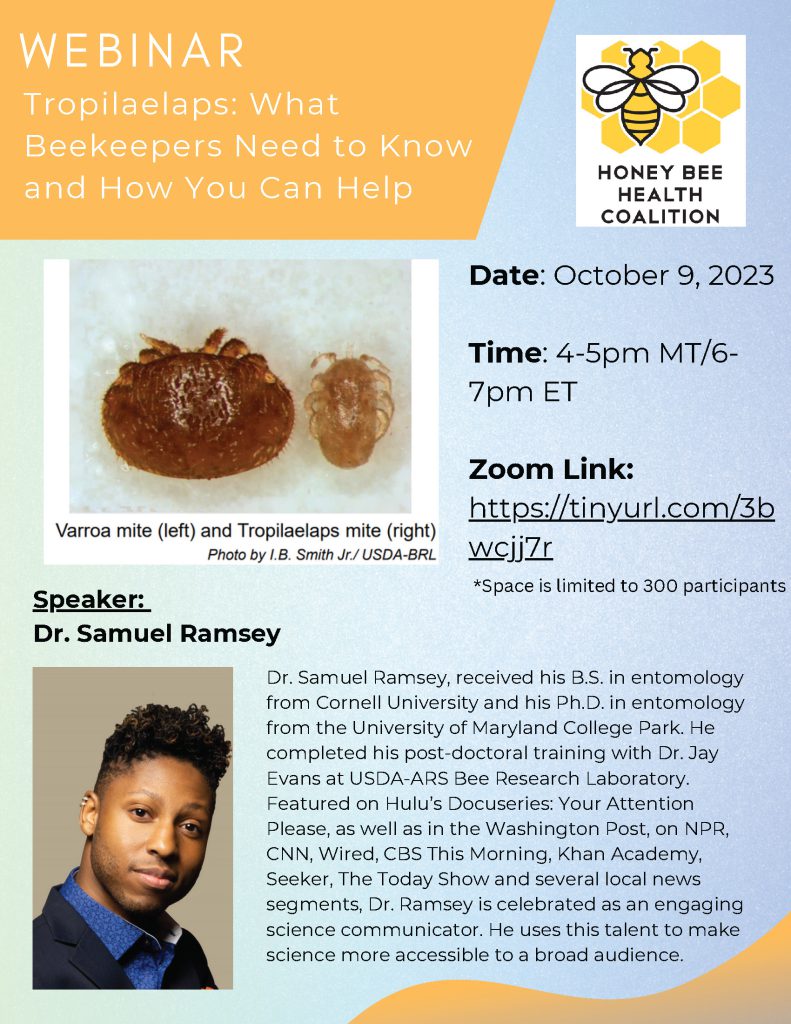
Link:
]]>The sweet stuff can help with burns, coughs, anxiety and more
By Alison Gwinn,
AARP
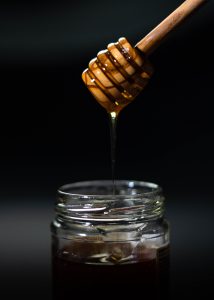
Photo by Daily Slowdown on Unsplash
Honey’s benefits have been touted since antiquity — and it turns out the ancient Greeks and Romans were onto something: Honey really can hit the sweet spot when it comes to our health.
Though honey — a sweet, sticky liquid made by honeybees from flower nectar — is technically a sugar, “it’s also really rich in a lot of different bioactive substances,” says Mayo Clinic registered dietitian (and hobbyist beekeeper) Joy Heimgartner. Those include a range of good-for-you minerals, probiotics, enzymes, antioxidants and other phytochemicals.
There are four common types of honey: Raw honey is defined by the National Honey Board as “honey as it exists in the beehive or as obtained by extraction, settling or straining without adding heat.” Manuka honey, produced from the flowers of manuka trees, is known for its unique antibacterial properties, attributed to a compound called methylglyoxal, says Jordan Hill, lead registered dietitian for Top Nutrition Coaching.
Organic honey is produced without the use of synthetic chemicals, pesticides or GMOs. And locally produced honey has been reported to provide relief from seasonal allergies to local pollen, though scientific evidence to support that claim is limited, says Hill.
According to Hill, honey can be substituted for sugar in recipes, but remember: It has a distinctive flavor (which varies depending on the source flowers); it’s sweeter than sugar (the general rule of thumb is to use ¾ to 1 cup of honey for every 1 cup of sugar); it’s a liquid, so you may need to cut back on other liquids or slightly increase the dry ingredients in a recipe; and it browns more quickly than sugar (so reduce the oven temperature by 25°F).
But whatever way you use honey — in a recipe or as a condiment — always keep in mind that it is a sweetener. “Honey is a supersaturated sugar solution, and we should limit added sugars of all types,” says Heimgartner. Still, “if you’re looking for a sweetener that has more to offer, honey is fantastic.” Here are six reasons why.
- Honey doesn’t raise your blood sugar as rapidly as white sugar
“Honey is metabolized differently from white sugar and produces less of a sugar spike,” says registered dietitian and nutritionist Dawn Jackson Blatner, author of The Flexitarian Diet. “Research suggests that honey may enhance insulin sensitivity and may support the pancreas, the organ that produces insulin.” A 2018 review of preliminary studies points to honey’s “hypoglycemic effect” and use as a “novel antidiabetic agent that might be of potential significance for the management of diabetes and its complications.”
And a 2022 study out of the University of Toronto found that honey improves important measures of cardiometabolic health, including blood sugar, cholesterol and triglyceride levels, especially if the honey is raw and from a single source.
- Honey can help with wound or burn therapy
“Honey has been used for wound healing for centuries, and certain types of honey, like medical-grade honey, have shown potential in wound management due to their antimicrobial properties and ability to promote healing,” says Hill, who nonetheless advises consulting health care professionals for appropriate wound care. Heimgartner, a board-certified oncology specialist, says, “There’s actually a lot of evidence that using honey during oral cancer radiation treatment helps to prevent some of the nasty side effects of mucositis,” or inflammation of the mouth.
How does it work? “Research suggests that honey prevents or controls the growth of bacteria on the wound, helps to slough off dead tissue and microorganisms, and transports oxygen and nutrients into a wound for quicker healing,” says Blatner.
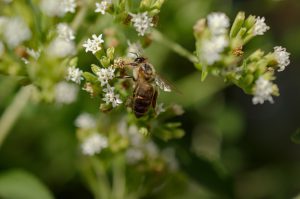
Native plants and naturalistic perennials attract bees and other pollinators.
Create Your Own Pollinator Garden
If you want to create your own pollinator garden for bees to forage in, consider these tips from Emily Erickson, postdoctoral researcher at the University of California, Davis, department of evolution and ecology.
- Opt for native plants or naturalistic perennials.
- Choose plants of varying colors, shapes and bloom times so you can support a variety of pollinators throughout the season.
- Avoid double-flowered varieties (those with extra petals) or plants that look drastically different from their wild relatives.
- Avoid pesticides.
- Leave areas in your yard that can serve as nesting habitats, such patches of bare soil, brush, twigs or woody stems, where many native pollinators make their homes.
- Which plants are right for you depends on your location and climate, so ask your local nursery for advice — or simply walk through a nursery and notice which plants seem to attract pollinators.
- Honey is rich in polyphenols, including flavonoids
Why does that matter? Because those two substances have both antioxidant and anti-inflammatory properties, meaning they protect our bodies against oxidative stress, which can manifest as cancer, heart disease or other diseases. But Hill cautions that the polyphenols in honeys can vary significantly, depending on the type of honey and its floral source.
- Honey can be an effective cough suppressant
A 2020 meta-analysis found that honey provides a widely available and inexpensive alternative to antibiotics in controlling cough frequency and severity, though it concluded that further studies were needed. “It is believed that honey’s thick texture and possible antioxidant and antimicrobial properties may provide relief for cough symptoms,” Hill says, but she adds the caveat that honey should never be given to infants under 1 year of age due to a risk of botulism.
- Honey may provide antidepressant or anti-anxiety benefits.
“Research suggests that polyphenol compounds in honey such as apigenin, caffeic acid, chrysin, ellagic acid and quercetin support a healthy nervous system, which may enhance memory and support mood,” says Blatner. Though more study is needed, a 2014 review of research says that one established nootropic (or cognitive-enhancing) property of honey “is that it assists the building and development of the entire central nervous system, particularly among newborn babies and preschool-age children, which leads to the improvement of memory and growth, a reduction of anxiety, and the enhancement of intellectual performance later in life.”
- Honey may support a healthy gut
Early research indicates that “honey has an extra-special ability to support a healthy gut microbiome because it contains both probiotics, or good bacteria, and prebiotic properties, which help good bacteria thrive,” says Blatner, though the evidence is limited. A 2022 paper funded by the National Institute of Health, Malaysia, concluded that “honey bees and honey, which have the potential to be good sources of probiotics and prebiotics, need to be given greater attention and more in-depth research so they can be taken to the next level.”
We are here to share current happenings in the bee industry. Bee Culture gathers and shares articles published by outside sources. For more information about this specific article, please visit the original publish source: https://www.aarp.org/health/healthy-living/info-2023/honey-health-benefits.html
]]>Reuters
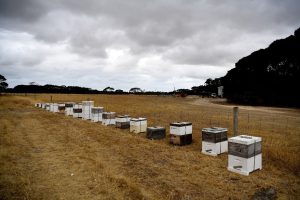
Bee hives at a farm on Kangaroo Island, Australia January 20, 2020. Picture taken January 20, 2020. REUTERS/Tracey Nearmy/File Photo
CANBERRA (Reuters) – The Australian government said it will stop trying to eradicate the Varroa mite, a parasite that kills honey bees, and will instead try to manage its spread, which is likely to make pollination of crops such as almonds more costly.
The decision ends an A$132 million ($85.3 million)eradication plan that has destroyed more than 14,000 hives in southeastern Australia since the mite was discovered there in June 2022.
The federal government said the decision was taken on Tuesday by the National Management Group (NMG), which is driving the Varroa programme nationwide.
In a statement on Wednesday, the New South Wales government, speaking on behalf of the NMG, said non-compliant and illegal movement of hives had spread the parasite further and made it impossible to contain.
Commercial crops including almonds, apples and avocados are dependent on pollination by European honey bees, with huge numbers of hives moved during spring flowering to bring bees to plants.
The Australian government has said a widespread mite infestation could destroy most wild European honey bee nests and managed hives not adapted to Varroa, reducing pollination and causing losses of over A$70 million a year.
“The recent spike in new detections have made it clear that the Varroa mite infestation is more widespread and has also been present for longer than first thought,” the New South Wales government said in a statement.
“The potential to eradicate is no longer possible… We now need to work collaboratively to manage and minimise the impact of Varroa.”
Varroa is a reddish-brown mite around 1 mm in diameter that attaches itself to European and Asian honey bees and feeds on them, weakening them and killing colonies.
The mite also carries viruses and has caused the collapse of honey bee populations around the world.
Varroa does not target native Australian honey bees.
We are here to share current happenings in the bee industry. Bee Culture gathers and shares articles published by outside sources. For more information about this specific article, please visit the original publish source: https://www.reuters.com/world/asia-pacific/australia-abandons-efforts-eradicate-deadly-honey-bee-parasite-2023-09-20/
]]>by Entomological Society of America
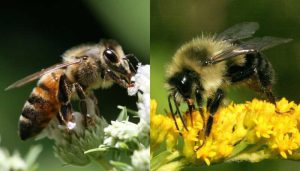
Responsible use of pesticides includes striving to avoid negative effects on the environment, often with an emphasis on protecting bees and other pollinators. A new study, however, finds that many common methods for minimizing pesticides’ impact on bees—even some recommendations on product labels—are backed by minimal scientific evidence. The researchers behind the study, published in the Journal of Economic Entomology, say stronger testing is needed to evaluate which bee-protection measures are truly effective and which ones may be too reliant on conventional wisdom. Moreover, nearly all of the research that has been conducted on these measures has focused on managed honey bees (left) while ignoring wild, native bees such as bumble bees (right) and other pollinators. Credit: (Honey bee photo by Chris Evans, University of Illinois; bumble bee photo by David Cappaert. Both photos via Bugwood.org)
Responsible use of pesticides includes striving to avoid negative effects on the environment, often with an emphasis on protecting bees and other pollinators. A new study, however, finds that many common methods for minimizing pesticides’ impact on bees—even some recommendations on product labels—are backed by minimal scientific evidence.
The researchers behind the study say stronger testing is needed to evaluate which bee-protection measures are truly effective and which ones may be too reliant on conventional wisdom. They share their analysis in a report published in the Journal of Economic Entomology.
Growers are urged to follow a variety of “mitigation measures” meant to protect bees during pesticide applications, such as spraying at night, using specific nozzles on sprayers, or maintaining buffer zones.
“It takes time, money, and effort to follow these rules, so if they are not actually helpful, they are a waste of time,” says Edward Straw, Ph.D., a postdoctoral researcher in the School of Agriculture and Food Science at University College Dublin (UCD) in Ireland and lead author on the study. “If they are helpful, though, they could be applied more widely, to protect bees further.”
Straw and colleague Dara Stanley, Ph.D., assistant professor in applied entomology at UCD, combed published, peer-reviewed research for studies that evaluated the effectiveness of any kind of mitigation measure in reducing a pesticide’s impact on bees. Just 34 studies matched their criteria, spread across a wide range of measures—but largely focused on just one kind of bee.
“Almost all research was centered around protecting honey bees. However, honey bees are a managed species that is not endangered,” Straw says. “When we try to protect bees, we really want to be protecting wild, unmanaged bee species, as these are the species which are in decline.”
Few mitigation measures had more than one or two studies evaluating their effectiveness, and methods of testing varied. For instance, some studies tested for direct overspray while others tested for longer-term pesticide residues. And just three studies among Straw and Stanley’s review evaluated measures frequently found on pesticide labels.
“Least researched was testing on how you time a pesticide spray, be that time of day or time of year,” Straw says. “There’s good reason to believe that if you change when you spray, you could avoid peaks in bee activity. Yet surprisingly no one has really researched if this idea works. This is odd, as it’s a very common mitigation measure and not overly hard to test.”
Other mitigation measures tested in existing studies included how pesticides are applied (e.g., spray parameters or planting methods for pesticide-coated seeds), buffer zones, removing flowering weeds before spraying, direct interventions for managed bees (e.g., moving or covering colonies), and applying pesticides only in certain weather conditions or during certain crop stages.
A newer method had the most studies (12) investigating its potential: repellent additives to pesticide sprays, which encourage bees to avoid a recently sprayed crop. Several compounds have shown promise in lab testing, but all 12 studies tested repellency for honey bees only, and none were tested in formulation with a pesticide—only on their own.
“It is an interesting idea, but it is not yet ready to be used,” says Straw. “It would need to be tested on a diversity of bee and insect species, as if it is only repellent to one or two species, all the other bees would still be exposed to the pesticide.”
In sum, Straw and Stanley say too much hinges on bee-protective measures for them to be weakly supported. Bees play a critical role in both natural ecosystems and agriculture, and the presumption that mitigation measures are effective can be factored into decisions to authorize pesticides for use. Rigorous scientific evaluation of these measures is imperative, they say.
“The main limitation is that these studies need to be big, well-funded pieces of research. To test changes to how a pesticide is applied to a crop, you need to have a crop, a pesticide sprayer, and someone licensed to spray. All of that is expensive and time consuming, making it out of reach for most scientists,” says Straw.
But, if such research can be generated, there’s reason to believe it will have immediate positive impacts. In related research Straw and Stanely published earlier this year, compliance with pesticide regulations and guidelines among farmers in an anonymous survey was high. “We know that these mitigation measures are being followed,” says Straw. “We just do not know if they are helpful yet.”
More information: Edward Straw et al, Weak evidence base for bee protective pesticide mitigation measures, Journal of Economic Entomology (2023). DOI: 10.1093/jee/toad118
Journal information: Journal of Economic Entomology
Provided by Entomological Society of America
We are here to share current happenings in the bee industry. Bee Culture gathers and shares articles published by outside sources. For more information about this specific article, please visit the original publish source: DOI: 10.1093/jee/toad118
]]>/ By Lucas Forbes, Bronwyn Herbert, Emily Doak, and Tina Quinn
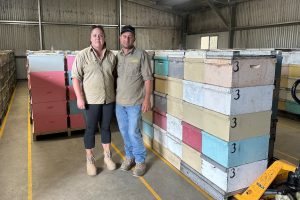
Beekeepers Denille Banham and Daniel Costa stand to lose all their hives due to varroa mite. (ABC News: Tina Quinn)
As authorities race to control the outbreak of varroa mite in Australia’s bee population, many beekeepers are saying it is time to learn to live with the mite.
Key points:
- A US bee health group is working on a “varroacide” to defeat the pest
- A New Zealand beekeeper says the worst effects of varroa mite were over in two years
- Beekeepers losing hives to euthanasia in Australia are calling for a policy shift from eradication to management
But what would that look like?
More than a year after varroa mite was first found at the Port of Newcastle, detections of the parasite have ramped up.
In recent weeks, thousands of beehives have been quarantined or euthanased after the mite was detected in hives in Kempsey on the NSW mid-north coast, many of which were delivered to parts of the Sunraysia and Riverina districts for almond pollination.
With Australia the only continent in the world where varroa has not taken hold, authorities have maintained a policy of eradication.
Varroa mites can destroy entire hives. (Supplied: Gilles San Martin)
For Kempsey beekeepers Denille Banham and Daniel Costa, the eradication strategy means their hives will be destroyed after varroa was found in some hives taken to Nericon, near Griffith, for the pollination season.
They have 750 hives in the eradication zones and 480 will have to be destroyed.
“Your 23 years of hard work, blood, sweat and tears, just all gone,” Mr Costa said.
Beekeepers are now calling for Australia to move towards managing the mite and living with it, instead of trying to eradicate it.
How is varroa mite managed?
The United States has been living with varroa mite since the late 1980s, when the pest was accidentally introduced to Florida.
The Honey Bee Health Coalition (HBHC) teaches beekeepers how to manage varroa mite and invests in research into developing pesticides that could kill the pest.
HBHC facilitator Matthew Mulica said varroa mite was so common in North America that if any hive did not have it now, it would within the next year.
That is why American beekeepers test for varroa two to four times a year.
If there are more than three mites per 100 bees, the coalition says beekeepers should start control measures immediately.
It is crucial to identify varroa to stop them spreading.
“If you do nothing, then in their last dying breath bees will fly off and infect other hives around you,” Mr Mulica said.
Regular testing carried out
One of the costs of management is hiring people to test hives and apply treatments.
Tumut beekeeper John Casey estimated his labour bill would double under a management policy, but said that would be preferable to staying with eradication.
“We’ve got 2,000 hives up at Euroley in the red zone. We don’t know if they’re going to let us move them or euthanase them,” he said.
“It’s a big loss of the bees and also the income we could make off them for the next couple of years.”
Hundreds of Belinda and John Casey’s hives have been impacted by measures aimed at controlling varroa mite. (ABC Rural: Emily Doak)
In the US, beekeepers can use chemical treatments to kill the mites, and there are some non-chemical techniques as well that interrupt the life cycle of the hive and slow varroa down.
Since varroa mite grows in the pupa of bees, producers can also remove the queen from the hive temporarily to reduce the number of pupa and cut down the opportunities for the mite to grow.
Mr Mulica said the HBHC was working with scientists in the US, Canada and Spain to create a “varroacide” to control the pest.
“We’re looking at all of these things and testing different compounds to find that next miracle molecule, if you will,” he said.
Varroa-resistant bees are also being developed which attack mites or kick infested bees out of the colony.
Silver linings in New Zealand
New Zealand beekeeper Barry Foster said the varroa mite outbreak in 2000 had put up to a third of beekeepers out of business, but there was a silver lining for those who remained.
Around the world varroa mites have killed off almost all the feral bees — the ones bred by beekeepers that escape into the wild.
Feral bees pollinate a lot of crops for free, but with fewer hives in the wild there is more demand for commercial pollination services, and that is what happened in New Zealand.
Mr Foster said beekeepers were paid more for their services and the industry recovered in just a couple of years.
“It was a fairly quick turnaround. Probably within a year or two we had gone through the most difficult learning and mental health period,” Mr Foster said.
He said the beekeeping industry had to adapt.
“You have to be a better beekeeper because of varroa and more on your game and better at planning,” he said.
We are here to share current happenings in the bee industry. Bee Culture gathers and shares articles published by outside sources. For more information about this specific article, please visit the original publish source: Bee pest varroa mite common in New Zealand and the US where beekeepers have learned to live with it – ABC News
]]>/ By Joanna Prendergast, Sophie Johnson, and Belinda Varischetti
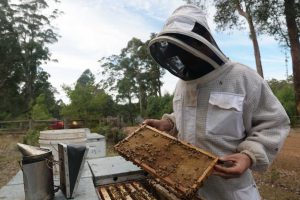
Pemberton beekeeper Mike Cernotta says WA needs to take the varroa threat more seriously. (ABC South West WA, Jon Daly)
West Australian honey producers say they are increasingly anxious about the spread of the destructive varroa mite across New South Wales and fear complacency has left the state’s industry ill-prepared for an outbreak.
Key points:
- As varroa spreads in NSW, the WA beekeeping industry is divided over whether eradication is still possible
- There are fears traffic moving from the east will inadvertently transport the destructive mite into WA
- But authorities say they are “incredibly confident” it can be kept out.
Varroa destructor attacks European honeybees and is regarded as one of the greatest threats to Australia’s honey and honey bee pollination plant industries.
It was detected in sentinel hives in NSW in June last year, but has spread to several new locations in recent weeks, prompting debate about whether eradication is possible, or if NSW should transition to a varroa management policy.
Pemberton beekeeper and WA Bee Industry Council vice chair Mike Cernotta said there was a “huge risk” of varroa entering WA through traffic on the east-west freight link or through swarms of feral bees, and the state was not prepared.
“We had a national blitz where we encouraged beekeepers all over the nation to do alcohol washes, which is the primary detection tool to look for varroa, and unfortunately the uptake in WA was relatively poor … I think it’s complacency,” he said.
“We are pleading with WA beekeepers to do the minimum.
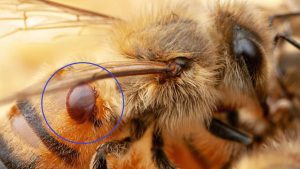
Varroa mite was first detected in Australian in June last year. (ABC Great Southern: Sophie Johnson)
“Time is ticking … the risk is growing, and we really need people to get serious about biosecurity, because otherwise we may find ourselves in a similar situation to NSW where we are scrambling to try and get on top of this pest. ”
Mr Cernotta said he supported eradication attempts continuing in NSW.
“I’d be lying if I said we didn’t have extreme levels of anxiety, because there is nothing we can do other than sit and watch,” he said.
“It’s devastating to see beekeepers facing [hive destruction], but the reality is they’re taking a hit for the rest of the nation’s beekeepers.”
Moving forward with varroa
Kim Fewster has been in the honey industry for 50 years, selling into a range of international markets…
To read the complete article go to; WA honey industry fears biosecurity ‘complacency’ has left state ill-prepared for a varroa mite outbreak – ABC News
We are here to share current happenings in the bee industry. Bee Culture gathers and shares articles published by outside sources. For more information about this specific article, please visit the original publish source: WA honey industry fears biosecurity ‘complacency’ has left state ill-prepared for a varroa mite outbreak – ABC News
]]>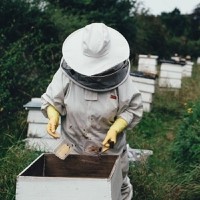
US-based researchers have successfully treated honey bees with a novel immune system booster for deadly viruses causing losses of the critical pollinator on a global level. Honey bees play a crucial role in our food system and production by pollinating crops, and their population decline, partly caused by viruses, is a direct danger to human health.
The scientists found that bees could fight many viruses when encouraging their cells to produce free radicals.
“This approach is especially exciting because it doesn’t just target a specific type of virus but helps with many different viruses,” says Daniel Swale, senior author of the study and the associate director for training and special projects in the UF Emerging Pathogens Institute and associate professor in the UF/IFAS entomology and nematology department.
“Additionally, we demonstrated that our treatment works in the lab and in colonies containing 80,000 bees in the field. This is huge because, in a hive setting, bees are exposed to so many different viruses and stressors, so successfully controlling viruses in that environment is very encouraging,” says Swale.
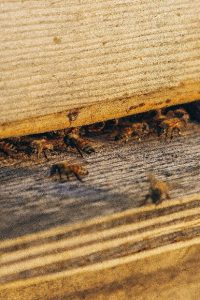
The protein was mixed with sugar water and drizzled over the honeycomb, making it accessible for the bees to consume.
A threatened specie
Michael Simone-Finstrom, a co-author of the study and a molecular research biologist with the ARS Honey Bee Breeding, Genetics and Physiology Research Lab in Louisiana, US, says that “varroa mites [a parasitic mite that attacks honey bees] are the number one cause of honey bee losses, but it’s important to point out that varroa mites, aside from physically weakening bees, also transmit viruses to bees.”
The researchers used a protein found in the cells of bees and most other “living things,” the compound pinacidil, which alters potassium ion channels and produces more free radicals.
“One of the big takeaways from this study is that potassium ion channels can be a target for improving immune system function in honey bees and possibly other insects. We would like to find a molecule, such as a peptide or a new technology that has the same effect as pinacidil but is more accessible to beekeepers,” says Swale.
The protein was mixed with sugar water and drizzled over the honeycomb, making it accessible for the bees to consume. The treatment showed protection from the Israeli acute paralysis virus, deformed wing viruses A and B, black queen cell virus and Lake Sinai viruses 1 and 2.
“While free radicals are often bad for cell health, they can be therapeutic in moderate amounts, as we see in this study. In this case, the additional free radicals signal to the immune system to ramp up, which helps the bees fight off viruses,” says Troy Anderson, a co-author of the paper and a professor of entomology at the University of Nebraska-Lincoln.
“If we can mitigate viruses in honey bee colonies, that would be a big step forward,” Simone-Finstrom adds.
The team of researchers says there are challenges in treating all commercial honey bees, although it “opens the door” to identify other, and maybe more cost-effective, treatments.
We are here to share current happenings in the bee industry. Bee Culture gathers and shares articles published by outside sources. For more information about this specific article, please visit the original publish source: Successful treatment for deadly honey bee viruses found in US study (nutritioninsight.com)
]]> Agricultural Research Service
Agricultural Research Service
U.S. DEPARTMENT OF AGRICULTURE
Varroa Mites and Deformed Wing Virus Make Honeybees More Susceptible to Insecticides
Contact: Jessica Ryan
Email: [email protected]
Controlling for Varroa mites, the parasitic mites that feed on honey bees and serve as vectors for viral diseases like deformed wing virus (DWV), can help with improving honeybee populations and make bees less susceptible to harmful insecticides, according to a recent study published in Environmental Pollution.
Foraging honey bees may be directly exposed to toxic insecticide sprays in the field or exposure may come from honeybees collecting and bringing pesticide-contaminated pollen and nectar back to their hives to feed larvae and young bees. The presence of insecticides, along with other environmental stressors in agricultural areas, can be a factor leading to issues like colony loss – something beekeepers from around the world are trying to overcome.
“Previous research has shown how chemicals like pesticides make bees more susceptible to mites,” said Yu-Cheng Zhu, a research entomologist at ARS’s Pollinator Health in Southern Crop Ecosystems Research Unit in Stoneville, Mississippi. “In our study, we wanted to see if mites and viral infestations make bees more susceptible to insecticides.”
In a study, researchers with the U.S. Department of Agriculture (USDA)’s Agricultural Research Service (ARS) applied the miticide amitraz (Apivar), a product commonly used for treating Varroa mites, off-label to four bee hives and left the other four hives untreated. They monitored the mite population density monthly and DWV density in early, middle, and late season.
Researchers collected bees from miticide-treated and untreated hives, and quantified gene expressions of four immune genes and two physiology-related genes. They also tested bees’ sensitivity to five representative insecticides. In addition, bees’ natural mortalities were recorded during three seasons.
“Miticide treatment led to minor or undetectable mite and DWV infestations during the whole bee season, while untreated colonies had substantially higher mite and DWV infestations,” said Zhu.
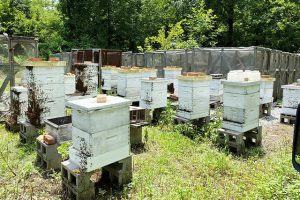
The first of two apiaries, established in 2014 in Stoneville, Mississippi, provided honey bees for studying the impact of pesticides on honey bees. (Photo by Yu-Cheng Zhu, D5121-1)
The data analyses showed that Varroa mite population irregularly fluctuated over the bee season and mite population density was not dynamically or closely correlated with the seasonal shift of honey bee natural mortality. Unlike mites, DWV density in untreated colonies progressively increased over the bee season. The density was highly correlated with the seasonal increase in honey bee natural mortality.
“In the untreated hives, the increased DWV infestations resulted in decreased physiological and immunity-related functions in late-season honey bees, making the bees more susceptible to insecticides and increasing natural morality rates during the season,” said Zhu.
According to Zhu, Varroa mites, also known as Varroa destructor, can reduce fat body and body fluids that contain important detoxification enzymes and immune proteins in honey bees. As a result, bees have impaired immune, detoxification/defense systems, and other essential processes. Coupling those impairments with exposure to insecticides can be detrimental to bee populations.
“Having impaired immunity, especially later in the season with fewer food sources, can be challenging for honey bees,” said Zhu.
Zhu, whose work focuses on the toxicological impact of pesticides on beneficial insects in the Mississippi Delta Area, said that the study’s results indicated the importance of studying the “bottom-up” effects of mite infestations on the overall health of honey bees in real-world contexts.
“Chemical control is still a major method in preventing crop loss and controlling insect pest populations,” said Zhu. “It is important to study the effects of chemical control in honey bee populations so we can find best practices for protecting the health of bees.”
We are here to share current happenings in the bee industry. Bee Culture gathers and shares articles published by outside sources. For more information about this specific article, please visit the original publish source: Varroa Mites and Deformed Wing Virus Make Honeybees More Susceptible to Insecticides : USDA ARS
]]>PPQ and Washington State Partners Get Ready for Another Hunting Season
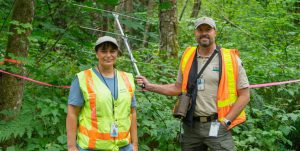
In 2021, visiting Oregon Department of Agriculture (ODA), entomologist Jessica Rendon and PPQ’s Plant Health Safeguarding Specialist Stacy Herron tracked a tagged northern giant hornet (NGH) to its nest in record time. The nest, which was successfully eradicated from an Alder tree, contained nearly 1,500 NGH life stages.
Tracking Northern Giant Hornet is An Adventure Like No Other
By Sharon Lucik
This is the final article in a 3-part Plant Protection Today series about the U.S Department of Agriculture’s Plant Protection and Quarantine program and the Washington State Department of Agriculture, and their response to the northern giant hornet (NGH).
The NGH (Vespa mandarinia) is a social wasp species. Its native range extends from northern India to East Asia. This pest was first reported in the Vancouver Island area of Canada in August 2019 and was also detected in Washington State that same year in December.
Most days you can find the U.S. Department of Agriculture’s Plant Protection and Quarantine’s (PPQ’s) Plant Health Safeguarding Specialist Stacy Herron at the U.S.-Canada land border crossing in Blaine, WA, conducting routine agriculture quarantine inspection duties. Other days, Herron is nowhere to be found because he’s hunting with his colleagues from the Washington State Department of Agriculture (WSDA). Not for deer, elk, or black bear. They’re hunting the largest hornet in the world—the northern giant hornet (NGH).
NGH was first detected in 2019, and from the onset Herron has been all in. He attends meetings, sets and monitors traps, responds to public sightings, and helps capture and tag live hornets and track them back to their nest. His enthusiasm and dedication to the work is mirrored by everyone on the team.
“This year the team will set more than 1,000 traps in northern Whatcom County,” said Herron. “Since this is our fourth trapping season, most landowners know what we’re doing and support us. Although we didn’t detect a single northern giant hornet last year, there’s no predicting what this season will bring. If we have a repeat and there are no detections, that means we’ll be one year closer to declaring NGH eradicated.”
The Hunt
According to Herron, the release of a tagged NGH can be exciting, frustrating, and even boring depending on what the hornet does. It may fly to a tree branch, land on the peak of a house, or head into the forest. Whatever path the hornets take, so does the tracking team—keeping the radio signal strong is central to finding their nests.
“We typically use a 3-person tracking team for each hornet release,” Herron said. “All of us carry a hand-held antenna connected to a radio receiver to monitor the tag’s signal, and mobile phones to communicate our location and signal strength. We wear headphones to hear the signal, neon vests so we can see each other in the distance, and ID badges because before we can enter a property, we first need to get permission from the landowners.”
Despite the team’s planning and preparations, they’ve had their share of unexpected challenges. The team found a radio tag in the underbrush that had fallen off the hornet they were tracking. On another occasion, overhead electrical powerlines interfered with the tag’s signal and confounded tracking for hours. And when a tagged hornet crossed the border into Canada, the team had to scramble and hand-off the tracking equipment to a Canadian apiary partner so their efforts could continue—only to have the hornet fly back over the border.
“We do our best and never lose sight of the endgame,” Herron said. “We’re determined and confident, and our track record speaks for itself. Our team has successfully located and eradicated 4 NGH nests, and if there are more nests out there, I’m optimistic that we will find and eliminate them too.”
We are here to share current happenings in the bee industry. Bee Culture gathers and shares articles published by outside sources. For more information about this specific article, please visit the original publish source: USDA APHIS | PPQ and Washington State Partners Get Ready for Another Hunting Season
]]>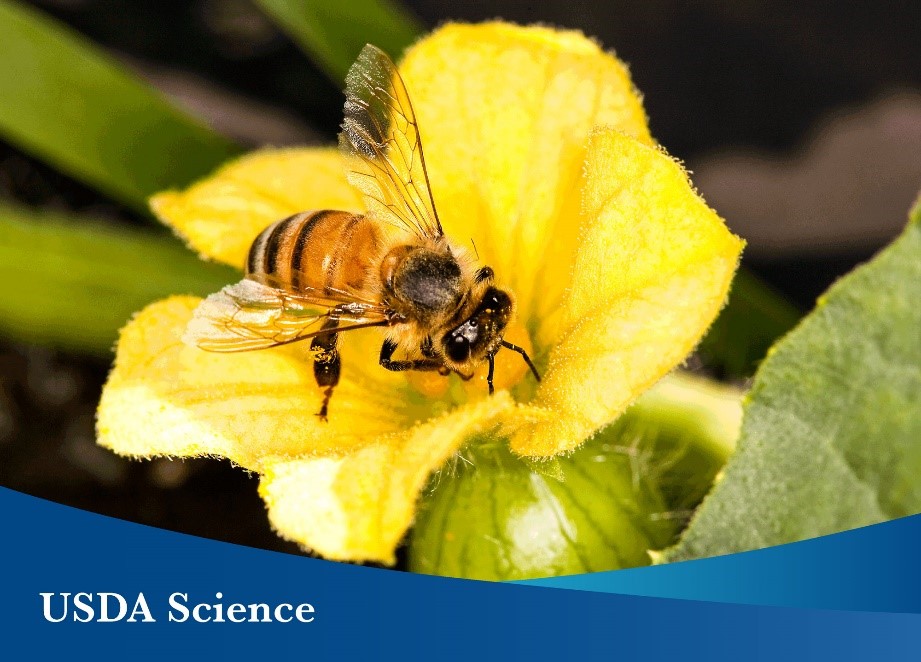 Breeding, Bees, and the 4 Ps
Breeding, Bees, and the 4 Ps
Posted by Scott Elliott, ARS Office of Communications in Research and Science
After suffering severe winter losses beginning in 2007, the honey bee population is making a comeback. Still, losses are high, which means beekeepers have to spend a lot of time and money replacing their bees.
Researchers with the U.S. Department of Agriculture’s (USDA’s) Agricultural Research Service (ARS) are responding, by using genetics to selectively breed honey bees to fight the primary perpetrators of the problem – what they call the “four Ps.” According to scientists with the ARS Honey Bee Breeding, Genetics, and Physiology Research (HBBGPR) lab in Baton Rouge, Louisiana, the main issues that honey bees contend with are parasites, pathogens, poor nutrition and pesticides.
Honey bees are important to ecosystems and the agriculture system. Honey bees are America’s primary commercial pollinator and more than 100 U.S.-grown crops rely on honey bees and other pollinators. In addition to their important role in maintaining food security, bees provide income to the entire food production industry from beekeepers and farmers to local retailers and international exporters.
The 5-year project at HBBGPR addresses the four Ps through breeding programs that refine selected genetic traits already present in honey bee populations.
“We are breeding honey bees that are more efficient at processing nutrients in their food and are more resistant to pests, pathogens and pesticides,” said Lanie Bilodeau, research leader at HBBGPR. “Developing healthier and more productive honey bee colonies will help ease the effects of disease and climate change, and improve the food supply at local, national and global scales.”
The project is already reaping positive results, including a comprehensive catalog of genetic variation of commercial and research honey bee populations in the country, and nutritional supplements for colony-wide pathogen treatment.
“We think of ourselves as good stewards and shapers of our [honey bee] populations, such that when we make our selection decisions the outcomes are healthier, stronger and more resilient honey bees,” said Arian Avalos, geneticist at HBBGPR.
National Pollinator Week was June19 to June 25. This annual celebration recognizes the important role pollinators play in our food and agricultural systems. Improving the health of honey bees through genomic research and honey bee breeding is just one way USDA is helping protect our nation’s precious pollinators. For more information on USDA’s work to enhance honey bee health, please visit: www.usda.gov/pollinators.
We are here to share current happenings in the bee industry. Bee Culture gathers and shares articles published by outside sources. For more information about this specific article, please visit the original publish source: https://www.usda.gov/media/blog/2023/06/20/breeding-bees-and-4-ps
]]>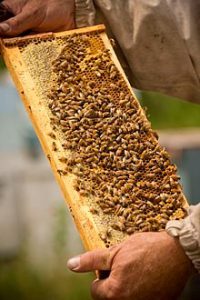 Without bees, there is no food, so keeping hives healthy is of utmost importance. That job is becoming more difficult thanks to an outbreak of disease and the effects of climate change.
Without bees, there is no food, so keeping hives healthy is of utmost importance. That job is becoming more difficult thanks to an outbreak of disease and the effects of climate change.
That’s where special apiary inspectors come in, who check on the health of keepers’ bees to help prevent the spread of honeybee diseases and pests.
Marie Cairns, a bee keeper who runs a small apiary in the Cowichan Valley, had her hives checked on Friday by Tara Galpin, an apiary inspector for South Vancouver Island and the Gulf Islands.
“First of all, it was all about the pollination, but then the more you learn about bees the more fascinating they are,” Cairns said.
Cairns has been bee keeping in the valley for nine years. She got her inspection for free, as any bee keeper can, so she can sell some of her hive.
“You have bees and you want your own bees to stay healthy, so you want their bees to be healthy because they fly and bring back disease if you don’t or mites or anything else,” she said.
Galpin is looking for a few different diseases and pests. One that comes up often is the varroa mite, a parasitic mite that feeds on honey bees and causes a disease called varroosis.
“They feed out the fat body of the bee, so it’s like if we had the size of a rat on our human body feeding on our liver,” Galpin explained.
Unfortunately, Cairns’ bees had too many mites. “My first time failing,” she said.
But this experienced bee keeper is unfazed, and will work with the inspector to apply the appropriate treatment.
Galpin says unpredictable spring weather due to climate change—that have been cooler and damper—is helping to spread fungal disease and doesn’t allow bees to forage for food when they need it most.
Keeping bees in good shape is important, as along with other native pollinators they play a key role in sustaining B.C.’s food system, and contribute an estimated $250 million to the province’s economy.
The inspector says losses this year in bee colonies is between 30 to 40 per cent—climate change and the spread of disease keeping the pressure on bees and their keepers.
“More than anything, we need diversity of plants for our bees to forage from and diversity in our food landscapes,” she said.
Importing bees plays a major role in maintaining the bee population across Canada, and combined with the work of inspectors like Galpin, they’re ensuring bees keep food on our table.
We are here to share current happenings in the bee industry. Bee Culture gathers and shares articles published by outside sources. For more information about this specific article, please visit the original publish source: Disease and climate change put pressure on bees and their keepers: apiary inspector | CTV News
]]> Bee aware that “Stop Varroa, Varroa Treatment” (through stopvarroa.com) does not have an EPA registration number and may not be a legitimate product approved for use in the U.S. to control varroa mite. Use of the EPA logo on the stopvarroa.com website has not been sanctioned by EPA, and the product “Varroa Treatment” does not have any indication as to what the active ingredient is in the product. All of these are warning signs that this may not be a legitimate product for controlling varroa mites.
Bee aware that “Stop Varroa, Varroa Treatment” (through stopvarroa.com) does not have an EPA registration number and may not be a legitimate product approved for use in the U.S. to control varroa mite. Use of the EPA logo on the stopvarroa.com website has not been sanctioned by EPA, and the product “Varroa Treatment” does not have any indication as to what the active ingredient is in the product. All of these are warning signs that this may not be a legitimate product for controlling varroa mites.
The website site lists many supposed positive attributes of the product, but they have not been proven or vetted.
Before you consider ordering this product, please check with your State or Regional Apiarist and State Pesticide Regulatory Agency. The National Pesticide Information Center (NPIC; http://npic.orst.edu/mlr.html) provides contact number for State Pesticide Regulatory agencies.
]]>by Scarlett Howard, Alexander Mikheyev, Emily Remnant, Simon Tierney and Théotime Colin, The Conversation
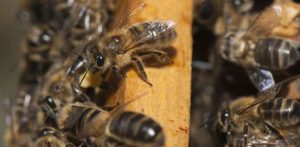
Credit: Théotime Colin, Author provided Varroa mites—notorious honey bee parasites—have recently reached Australian shores, detected at the Port of Newcastle in New South Wales last year. If they establish here, there would be significant implications for agricultural food security, as honey bees are heavily relied on for the pollination of many crops.
However, while Australia is the last continent to be invaded by the mite, it has an opportunity to be the first to eradicate it.
Varroa destructor is a small mite that attaches to bees and eats their “fat body.” The fat bodies of honey bees are the insect equivalent of a liver. Varroa weakens bees, reduces their lifespan and increases the spread of deadly viruses.
Scientists need to be ready: this might be Australia’s best chance to collect important data on the spread and evolution of this parasite. Our new paper published today in Biology Letters outlines what questions scientists need to ask and what data they need to collect if Varroa spreads in Australia.
Such data could help us understand how parasites evolve, why Varroa are so damaging for honey bees, and how Varroa mites impact other insects and the environment.
Will Varroa establish in Australia?
Australia is in close proximity to countries that have the mite, including New Zealand, Papua New Guinea, Timor-Leste and Indonesia.
This probably explains why invasive honey bee swarms are frequently intercepted at our ports, many of these carrying Varroa. Australia currently bans importation of honey bee colonies due to the biosecurity risk, so these interceptions are typically due to stowaway swarms taking up residence in shipping containers.
Previous invasions of Varroa have been successfully eradicated before establishing, but this time Varroa circumvented the biosecurity surveillance near Newcastle and spread locally.
The New South Wales Department of Primary Industries has been contact-tracing and culling hives in contaminated areas, and the spread has been slow so far. Australia has large populations of feral honey bees, which could potentially act as a reservoir for Varroa and are much harder to trace and control, so the department is tackling this with a wild honey bee baiting program.
What threats does Varroa pose?
Varroa mites are a threat to food security. Although Australia has an abundance of food and exports it to other nations, the price of food is likely to increase if Varroa escapes confinement.
Currently, pollination of crops in eradication zones such as berries in Coffs Harbor is at risk due to the removal of all honey bees in the region, which may lead to short-term increases in food costs.
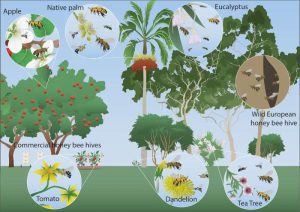
Australia currently relies on pollination by commercial honey bees (yellow), supplemented by feral honey bees (brown), though we have many native bee species like stingless bees and blue banded bees that are also being used in crop pollination. Credit: Boris Yagound, adapted from Chapman et al. 2023, CC BY
However, establishment and spread of Varroa will lead to lower pollination and lower crop production across the country, which will raise the price of most fruit and vegetables that depend on bee pollination.
This could worsen the food affordability crises caused by the current inflation, affecting the ability of low income households to buy nutritious and fresh produce. Almond pollination has already noted a deficit of 80,000 hives in the last season.
Many of the honey bee colonies that pollinate our crops are thought to be feral, living in tree hollows or nest-boxes designed for native animals. These feral bees are not managed by beekeepers and so won’t be saved by the use of Varroa treatments, meaning they will most likely disappear.
To read the complete article go to; Opinion: Australia is in a unique position to eliminate the bee-killing Varroa mite. Here’s what happens if we don’t (phys.org)
We are here to share current happenings in the bee industry. Bee Culture gathers and shares articles published by outside sources. For more information about this specific article, please visit the original publish source: Opinion: Australia is in a unique position to eliminate the bee-killing Varroa mite. Here’s what happens if we don’t (phys.org)
]]>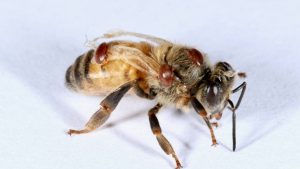
Varroa mites are responsible for the loss of tens of thousands of hives in New Zealand each year, killing countless bees like this one. Photo / Supplied
A destructive mite plaguing our beekeeping industry may have been building up home-grown resistance to a widely used chemical pesticide, a new study suggests.
Flumethrin has long been a key tool for controlling varroa, but when researchers recently assessed its mite-killing performance at one apiary, they found concentrations of it needed to be 13 times higher than two decades ago.
They say the findings, just released ahead of peer review, warrant further investigation to see if miticide resistance is a wider, hidden problem for the $5 billion industry.
Since being first detected back in 2000, the varroa destructor mite has become the sector’s biggest headache, each year accounting for nearly half of colony losses and costing more than $1 million in mitigation efforts and lost honey production.
The new study, led by PhD student Rose McGruddy and co-authored by Lester, focused on two key chemical pesticides used for varroa control.
They were flumethrin and amitraz – estimated to be used by 78 and 85 per cent of commercial beekeepers respectively.
Typically, they applied one product in early spring, and another in late summer or early autumn.
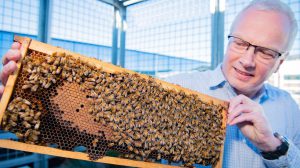
“Mite resistance to flumethrin may help explain why the mite problem is getting worse,” Victoria University ecologist Professor Phil Lester says. Photo / Supplied
“We’ve heard differing reports of the effectiveness of chemical pesticides, especially flumethrin,” Lester said.
“The nationwide survey and Rose’s data suggest most beekeepers are satisfied with it.
“But there are others who think this product is much less effective than it used to be – some even stating it has failed to control varroa entirely.”
Unlike in the past, some beekeepers were now using more than two applications of it, he said.
In the study, the researchers drew on years of survey data, along with their own laboratory tests of pesticides.
“The key result was that we found that the concentration of flumethrin needed to kill mites was 13-times higher than it was in 2005,” Lester said.
“This result indicates that mites appear to have and are developing resistance to this chemical.”
There was no evidence of any resistance to amitraz, which is another key pesticide for mite control, as it appeared to be effective, he said.
The study team stressed this result didn’t mean that commercial products containing flumethrin didn’t work – and they might still be useful for mite control for many beekeepers.
“We’d also note that the mites we used for this work were from the Wellington region and we can’t be sure that selection for resistance has occurred everywhere equally,” he said.
“But the big implication is that resistance does seem to have developed. It could explain the limited success of control using flumethrin reported to us by beekeepers.
“Mite resistance to flumethrin may help explain why the mite problem is getting worse.”
While varroa resistance to the chemical had been observed around the world, the study team didn’t find any of the same genetic markers of resistance identified in overseas studies.
“The New Zealand resistance development seems to be via a different pathway for the New Zealand population of mites,” Lester said.
The study raised several questions that urgently needed answering: namely, whether such “home-grown” was occurring more widely and, if so, how.
More broadly, Lester felt new products were needed for mite control, with novel modes of action – such as new “gene-silencing” approaches his own group was researching.
“We need to carefully manage resistance, by ensuring good integrated pest management procedures, which include alternating control methods,” he said.
“New methods are desperately needed.”
The industry’s peak body, Apiculture New Zealand, also said the study’s findings needed to be interpreted with caution.
“Because there has been growing discussion that resistance to treatments may be an issue in New Zealand, this research is of interest,” it told the Herald in a statement.
“However, although these lab concentrations differ to what was detected in 2003, they remain lower than what was detected in international apiaries with resistant varroa.
“Additionally, we note that the varroa tested in this research was collected from one apiary so it may not represent all regions.”
The group said this needed to be fully tested before any conclusions could be made regarding chemical resistance.
“As outlined by the researchers and by ApiNZ and our experts, the key to varroa management is ensuring the control methods are conducted as per label and rotated between treatment groups,” it said.
“Untreated colonies die. This does not change.”
We are here to share current happenings in the bee industry. Bee Culture gathers and shares articles published by outside sources. For more information about this specific article, please visit the original publish source: Has the destructive varroa been building ‘home-grown’ pesticide resistance in NZ? – NZ Herald
]]>